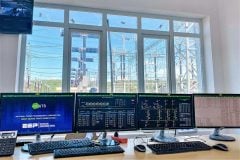Reliable operation of the primary system
Secondary systems are all those facilities needed to ensure reliable operation of the primary system, e.g. a high voltage substation. They cover the functions of controlling, interlocking, signalling and monitoring, measuring, counting, recording and protecting.

With conventional secondary systems, the various functions are performed by separate devices (discrete components) which mostly work on the analogue principle and as a rule are of varying sophistication.
Old technology
The resulting situation is as follows:
- Each task is performed by devices employing different technologies (electromechanical, electronic, solid-state or microprocessor-based).
- These discrete devices may require many different auxiliary voltages and power supply concepts.
- The links between the devices and with the switchgear require a great deal of wiring or cabling and means of matching.
- The information from the switching apparatus has to be applied separately to numerous inputs for protection, control, interlocks etc., so monitoring the interfaces is complicated.
- Checking the performance of the individual devices is accompanied by more difficult verification of overall performance.
With the new control technology for switching installations, the emphasis is on the system and its function as a whole. Digital methods are employed for the respective functions, using programmable modules based on microprocessors.
9 new technology features
The distinguishing features of the new technology are:
- Use of identical device components or combined devices based on microprocessors for the various tasks or functions.
- Standardized power supply and supply concept.
- Serial data transfer minimizes wiring (bus technique).
- Fibre optic cables are used near the process to reduce the cost of established adequate electromagnetic compatibility.
- Composite use made of data from the switchgear.
- Self-diagnosis with continuous function check-up, hence simpler testing of overall system and subsystem.
- Simple correct-sequence signal acquisition with a resolution of about 1 ms.
- Reduced space requirements.
- Records of station functions.
Another major innovation of the new approach is the man-machine interface (MMI).
While the access interface to conventional secondary technology is switch panel- or mimic control panel-oriented with the elements of switches, buttons, lamps and analogue instrumentation, access to the new control systems is usually through a display at bay level and through monitors and keyboards at substation and system control centre level.
Operation is mostly menu-guided, so no programming or computer skills are necessary.
Reference: Switchgear Manual ABB











ThankYou:-)
MS. Electrical engineer.
ur article are always helpful…thanks.
plz remove the floting bar..its annoying and creat problem in mobile view..
Please be more clear about foating bar?